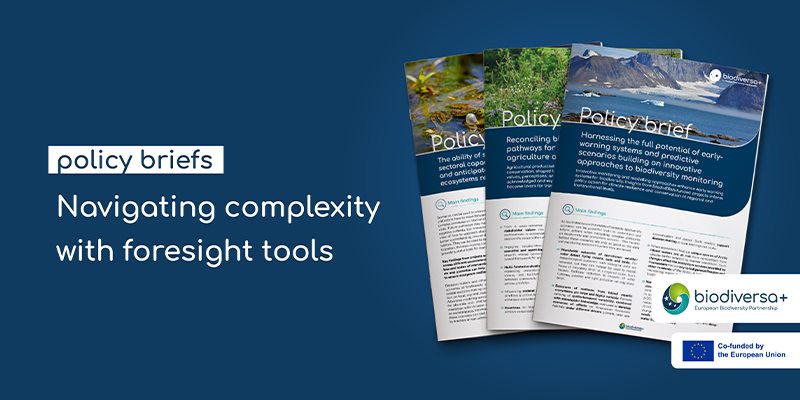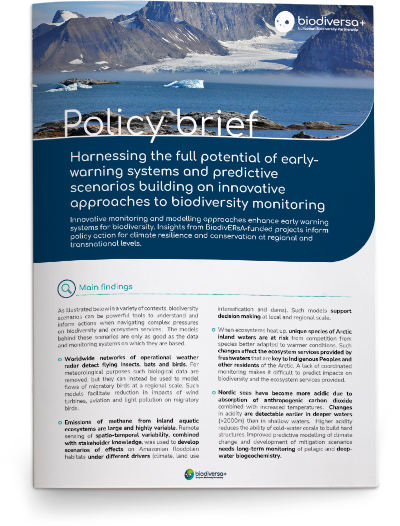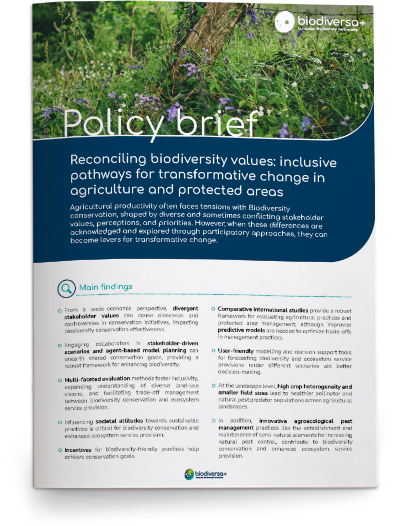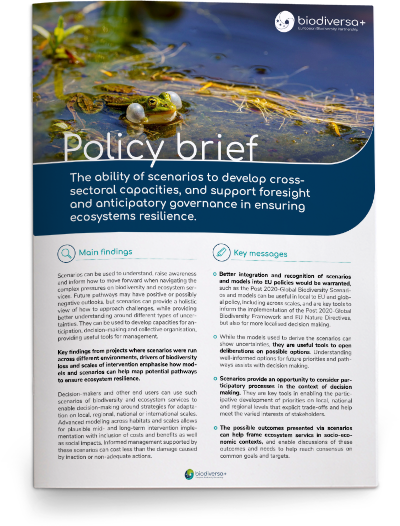Biodiversa+ is pleased to announce a new series of policy briefs developed under the BiodivScen call on “Scenarios of biodiversity and ecosystem services.”
In the face of urgent, interconnected challenges like environmental change and biodiversity loss, BiodivScen projects explored how foresight approaches can support better decision-making. The resulting briefs show how tools such as scenarios and early warning systems (EWS) can help navigate uncertainty, examine multiple possible futures, and promote collaboration across sectors and governance levels.
The briefs recommend key approaches:
- Co-developing scenarios with diverse stakeholders through participatory methods
- Embedding scenario approaches within policy frameworks from local to international scales
- Investing in modelling capacity, data access, and long-term monitoring infrastructure
- Building user capacity with accessible tools and training
- Strategically applying scenarios to anticipate risks, manage trade-offs, and promote sustainable land use and conservation
They also offer insights and recommendations for specific challenges, including:
- Managing trade-offs in agricultural landscapes and protected areas
- Supporting biodiversity-friendly land use and urban planning
- Forecasting impacts of biological invasions
- Identifying early warning signals in Arctic, oceanic, and freshwater systems
Harnessing early warning systems and predictive scenarios
Challenge: Ecosystems are shaped by complex, large-scale factors, yet monitoring remains fragmented and often limited to national or local scales, hindering broad-scale prediction.
Solution: Robust early warning systems
Drawing on research from ACCES, ARCTIC-BIODIVER, BONDS, GloBAM, & REEF-FUTURES, this brief explores how innovative monitoring tools (such as radar tracking, remote sensing, and ecosystem modelling) are strengthening EWS to anticipate and manage biodiversity and climate-related risks.
Key takeaways include:
- Bridging knowledge systems by integrating local, scientific, and policy knowledge to enhance early warning relevance and uptake.
- Co-designing EWS with stakeholders to ensure usability, trust, and legitimacy.
- Strengthening policy and regional coordination to translate robust data into timely action.
- Ensuring early warnings are clearly communicated and linked to institutional response capacities.
Specific recommendations include:
- Leveraging weather radar networks by using data on flying insects, bats, and birds (typically filtered out in meteorological analyses) to model migratory flows and reduce risks from wind turbines, aviation, and light pollution.
- Combining remote sensing with local knowledge to monitor methane emissions from inland waters over time and space, informing floodplain management scenarios under varying environmental drivers.
- Coordinating Arctic monitoring to predict and manage the impact of warming ecosystems on unique inland water species and the ecosystem services vital to Indigenous Peoples and local communities.
- Establishing deep ocean early detection systems and sustain long-term biogeochemical monitoring in the Nordic Seas and North Atlantic to track stressors relevant to biodiversity.
- Read the brief: Harnessing early-warning systems and predictive scenarios
- You can watch the presentations from ACCES, ARCTIC-BIODIVER, BONDS, GloBAM, & REEF-FUTURES at the BiodivScen Final Conference.
Reconciling different biodiversity values for better decisions
Challenge: Biodiversity holds ecological, cultural, economic, and intrinsic value. However, these diverse perspectives are often poorly integrated into decision-making. Agricultural productivity often conflicts with biodiversity goals, and differing stakeholder values can undermine conservation efforts.
Solution: Inclusive transformation
Drawing on research from ENVISION, OBServ, and SECBIVIT, this brief offers recommendations for recognising, articulating, and reconciling multiple biodiversity values in policy and practice. Drawing on agriculture and land use examples, it shows how participatory scenario-building can bridge divergent stakeholder views by engaging farmers, conservationists, and local communities to co-design socially acceptable, locally adapted solutions balancing conservation and productivity.
Key takeaways include:
- Recognising value pluralism by basing decisions on a broad understanding of biodiversity values beyond economic metrics.
- Using deliberative processes to surface diverse perspectives and build consensus.
- Supporting interdisciplinary tools and knowledge by integrating social sciences and humanities insights to deepen value understanding.
- Tailoring valuation methods and embracing diverse data to reconcile differing perspectives in context.
Specific recommendations include:
- Building on international studies and developing predictive tools, enhancing modelling capacity to evaluate agricultural practices, support biodiversity and pollinator populations, and inform scenario-based planning.
- Promoting diverse, biodiversity-friendly farming systems by encouraging smallholder operations, crop heterogeneity, and reduced field sizes, and by integrating semi-natural habitatsto support pest control and ecosystem service provision.
- Strengthening education, extension services, and farmer-led innovation to raise environmental awareness, support the adoption of sustainable agroecological practices, and foster adaptive responses to changing conditions.
- Adopting flexible, evidence-based policy frameworks that incentivise biodiversity-positive practices, support pesticide reduction, and enable innovation in sustainable farming.
- Read the brief: Reconciling biodiversity values in agriculture and Protected Areas
- You can watch the presentations from ENVISION, OBServ, and SECBIVIT at the BiodivScen Final Conference.
Strengthening foresight and anticipatory governance
Challenge: Growing ecological pressures and uncertainty demand approaches that go beyond traditional planning to ensure long-term resilience.
Solution: resilience through scenario use
Drawing on research from AlienScenarios, BioDiv-Support, InvasiBES, LimnoScenES, and Wild Health, this brief highlights how scenarios enable exploration of plausible futures and trade-offs, fostering understanding, awareness, and cross-sectoral collaboration to co-design locally relevant, cost-effective interventions.
Key takeaways include:
- Enhancing preparedness by helping decision-makers understand potential risks, trade-offs, and opportunities.
- Supporting resilience with adaptive, future-oriented biodiversity policies.
- Increasing relevance and capacity through participatory scenario co-creation that reflects real-world concerns and enables cross-sectoral collaboration.
- Committing to sustained investment as building impactful scenario capacities requires ongoing effort for effective policy integration.
Specific recommendations include:
- Applying scenarios at multiple scales, from local to international, to guide biodiversity and ecosystem service strategies.
- Using advanced scenario-based modelling across habitats and scales to support mid- and long-term planning considering costs, benefits, and social impacts.
- Supporting cost-effective management by informing decisions with scenarios to avoid inaction or poorly targeted measures.
- Integrating scenario approaches more fully into EU policy frameworks, including the Kunming-Montreal Global Biodiversity Framework and EU Nature Directives.
- Read the brief: The ability of scenarios to develop cross-sectoral capacities and support anticipatory governance
- You can watch the presentations from AlienScenarios, BioDiv-Support, InvasiBES, and LimnoScenES at the BiodivScen Final Conference.
These briefs reaffirm the importance of integrating foresight and participatory methods in biodiversity science and policy. They are intended to inspire more inclusive, forward-looking, and responsive biodiversity governance across Europe and beyond.







